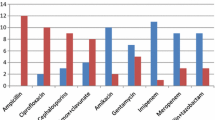Abstract
Objective
To determine the risk factors causing re-laparotomy and the indications, management and outcomes of re-laparotomy after a cesarean section.
Methods
We had, during the study period of January 2002 to January 2007, 28,799 cesarean sections and 35 cases with re-laparotomy. We studied the patients’ age, parity, indications for cesarean section and indications for re-laparotomy, time interval after cesarean section to reopening of the abdomen, type of surgery, need for blood transfusion and span of hospital stay.
Results
The incidence of re-laparotomy was 0.12%. Cases with placental abruption and previous cesarean ≥3 had a higher risk for re-laparotomy. Procedures that were performed at re-laparotomy were drainage and resuturing of hematomas (n = 8), resuturing of uterus and securing hemostasis with stitches (n = 10), bladder repair (n = 1), herniation repair (n = 1), total abdominal hysterectomy (n = 2), subtotal abdominal hysterectomy (n = 5), and draining and resuturing of broad ligament, parametrium, abdominal wound, and cutaneus and subcutaneous tissue due to infection and abscess formation (n = 8). Two cases required admission into the intensive care unit. We had one case with maternal mortality. Majority of the complications were revealed at an early period and these were hemorrhagic cases mostly.
Conclusion
Although the rate of re-laparotomy after cesarean section is low, several actions must be undertaken to decrease the need for re-laparotomy. In particular, cases with placental abruption and previous cesarean ≥3 are with higher risk for re-laparotomy and have a 15-fold risk for re-laparotomy after cesarean section.
Similar content being viewed by others
References
Greenhill JP (1995) Obstetrics, 11th edn. Saunders, Philadelphia, pp 986–1033
Jackson NV, Irvine LM (1998) The influence of maternal request on elective cesarean section rate. J Obstet Gynaecol 18:115–119
Landon MB (2007) Cesarean delivery. Gabbe SG, Niebyl JR, Simpson JH (eds) 5th edition. Churchill Livingstone, Philadelphia, pp 486–521
Rubin GL, Peterson HB, Robert RW, McCarthy BJ, Terry JS (1981) Maternal death after cesarean section in Georgia. Am J Obstet Gynecol 139:681–685
Zelop C, Heffner LJ (2004) The downside of cesarean delivery: short- and long-term complications. Clin Obstet Gynecol 47:386–393
Mayer HG, Limberger M (1975) Early abdominal second interventions following gynecologic surgery. Zentralbl Gynakol 97:692–695
Saffah SE (2005) Re-laparotomy after cesarean. Int J Gynaecol Obstet 88:253–257
Lurie S, Sadan O, Golan A (2007) Re-laparotomy after cesarean section. Eur J Obstet Gynecol Reprod Biol 134:184–187
Clark SL, Belfort MA, Hankins GDV, Meyers JA, Houser FM (2007) Variations in the rates of operative delivery in the United States. Am J Obstet Gynecol 196:526.e1–5
Ribeiro VS, Figueiredo FP, Silva AA, Bettiol H, Batista RF, Coimbra LC, Lamy ZC, Barbieri MA (2007) Why are the rates of cesarean section in Brazil higher in more developed cities than in less developed ones? Braz J Med Biol Res 40:1211–1220
Abenhaim HA, Benjamin A, Koby RD, Kinch RA, Kramer MS (2007) Comparison of obstetric outcomes between on-call and patients’ own obstetricians. CMAJ 177:352–6
Leung GM, Ho LM, Tin KY, Schooling CM, Lam TH (2007) Health care consequences of cesarean birth during the first 18 months of life. Epidemiology 18:479–484
Lehmann S, Børdahl PE, Rasmussen SA, Irgens LM (2007) Norwegian midwives and doctors have increased cesarean section rates. Acta Obstet Gynecol Scand 86:1087–1089
Anonymous (1985) Appropiate technology for birth. Lancet 2:436–437
Martin JA, Hamilton BE, Sutton PD, Ventura SJ, Menacker F, Kirmeyer S (2006) Births: final data for 2004. Natl Vital Stat Rep 55:1–101
Cahill AG, Macones GA (2007) Vaginal birth after cesarean delivery: evidence-based practice. Clin Obstet Gynecol. 50:518–525
Ophir E, Strulov A, Solt I, Michlin R, Buryanov I, Bornstein J (2007) Delivery mode and maternal rehospitalization. Arch Gynecol Obstet. [Epub ahead of print]
Simoes E, Kunz S, Bosing-Schwenkglenks M, Schmahl FW (2005) Association between method of delivery, puerperal complication rate and postpartum hysterectomy. Arch Gynecol Obstet 272:43–47
Ceydeli A, Rucinski J, Wise L (2005) Finding the best abdominal closure: an evidence-based review of the literature. Curr Surg 62:220–225
Berghella V, Baxter JK, Chauhan SP (2005) Evidence-based surgery for cesarean delivery. Am J Obstet Gynecol 193:1607–1617
Davis JD (1999) Management of injuries of the urinary and gastrointestinal tract during cesarean section. Obstet Gynecol Clin North Am 26:469–480
Opøien HK, Valbø A, Grinde-Andersen A, Walberg M (2007) Post-cesarean surgical site infections according to CDC standards: rates and risk factors. A prospective cohort study. Acta Obstet Gynecol Scand 86(9):1097–1102
Nadisauskiene RJ, Kliucinskas M, Vitkauskiene A, Minkauskiene M, Vaitkiene D (2007) Puerperal Clostridium perfringens sepsis in a patient with granulocytopenia. Gynecol Obstet Invest 65:32–34
Montavon C, Krause E, Holzgreve W, Hosli I (2005) Uterine gas gangrene through Clostridium perfringens sepsis after uterus rupture postpartum (in German). Z Geburtshilfe Neonatol 209:167–172
Halpin TF, Molinari JA (2002) Diagnosis and management of Clostridium perfringens sepsis and uterine gas gangrene. Obstet Gynecol Surv 57:53–57
Alchalabi HA, Amarin ZO, Badria LF, Zayed FF (2007) Does the number of previous caesarean deliveries affect maternal outcome and complication rates? East Mediterr Health J 13:544–550
Author information
Authors and Affiliations
Corresponding author
Rights and permissions
About this article
Cite this article
Gedikbasi, A., Akyol, A., Asar, E. et al. Re-laparotomy after cesarean section: operative complications in surgical delivery. Arch Gynecol Obstet 278, 419–425 (2008). https://doi.org/10.1007/s00404-008-0604-9
Received:
Accepted:
Published:
Issue Date:
DOI: https://doi.org/10.1007/s00404-008-0604-9



